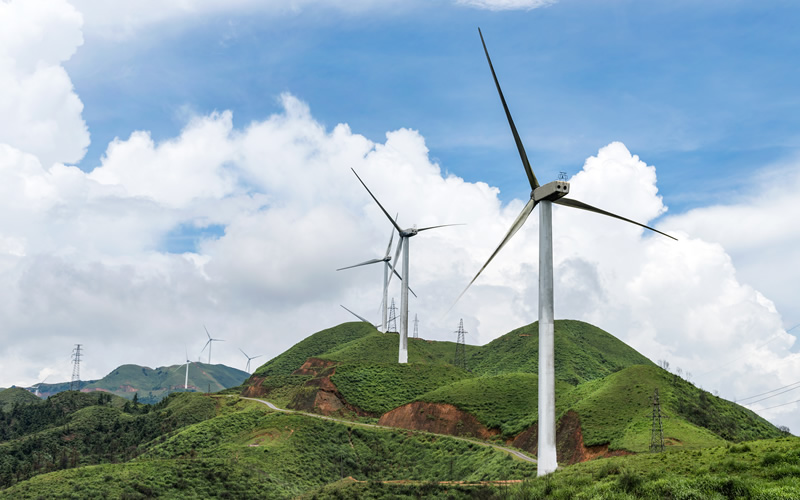Advantages and Disadvantages of Wind Power

As society moves away from an energy system dominated by fossil fuels, we must implement sustainable and renewable energy sources. Most people are familiar with wind power, but do the benefits outweigh the costs of its use? The following are many of the advantages and disadvantages of using wind power as an energy source.
Advantages of wind power
- Free Fuel
Unlike costly fossil fuels, the wind is free and all around us, whether we harness it for our energy use or not.
- Clean and Renewable Energy Source
Unlike fossil fuels, the production of electricity from the wind does not pollute our air, water, or land with particulates or greenhouse gases. Wind is a renewable energy resource that we won’t run out of.
- Independent Energy Resource
Wind energy systems can be set up independently of a grid, so wind turbines are ideal for the production of electricity in rural areas or in developing countries that lack substantial infrastructure[sc:1].
- Range of Sizes
Wind turbines come in a variety of sizes, and therefore can be retrofitted to fit a variety of sites, including residential, business, and municipal sites[sc:1].
- Local and Domestic Energy Resource
Wind power is a domestic energy resource and does not require the importation of fuel resources from other nations as fossil fuels do[sc:2]. This is very good for national security and energy independence, as nations can produce their own energy without having to rely on outside resources[sc:3].
Wind farms are normally locally owned and managed, providing many opportunities to create both short-term and long-term locally-generated jobs, and the wind farms help to boost and diversify rural economies[sc:3].
- Cost-effective Energy Production
Once wind farms have been constructed, they produce energy very inexpensively. It is estimated that wind power can currently be produced for approximately 2.5 -5 cents/kWh, which is very price-competitive with conventional energy sources[sc:3][sc:comma][sc:4].
- Wind farms can be built on existing farms and ranches and they help to preserve space
Wind turbines have a very small footprint on a given piece of land, and can therefore be combined with other land uses, such as farming or grazing[sc:3].
- Price Stability
While fossil fuel prices are extremely volatile, the price of wind as an energy resource is generally consistent and stable[sc:3].
- Mining and fuel transportation decreased
Wind power requires no fuel that needs to be mined or transported, decreasing our overall demand for these activities[sc:3].
Disadvantages of wind power
- Unpredictable availability of wind
Wind doesn’t blow continually, and therefore is not constantly available as an energy source. To compensate for this, the supply of wind is monitored and compensated by wind energy providers similarly to how changes in conventional electricity demand are monitored and compensated for over a 24-hour period[sc:3].
- Wind farms alter natural landscapes and can create visual and noise “pollution”
To some, wind turbines negatively alter natural landscapes that should be preserved in their natural states. Others find the aesthetics of wind turbines undesirable. Wind turbines produce some noise when they are running, but as wind turbine technology has evolved, they now produce less noise than in the past. Modern wind turbines should not disrupt everyday activities such as softly conversing with one’s neighbors[sc:1].
- Large wind farms are needed to produce a significant supply of electricity
In order to produce a lot of energy, many turbines are required. For instance, one large turbine is needed to supply enough energy for 475 homes, so larger communities would need many turbines to supply all of their electricity[sc:1].
- Some pollution may be produced during turbine manufacturing
While the electricity that is generated by wind power is non-polluting, there may be some pollution that is produced during the manufacture of wind turbines[sc:1].
- Good wind sites are rural, while electrical grids are in cities
Ideal wind power sites are situated in rural areas where there is ample wind[sc:2]. The grids of many cities may be far away from this power source, requiring wind-generated electricity to be transported long distances before it is consumed.
- Profitability
Other land uses may be more profitable than wind farms are, and their development may have to compete with other potential economic uses of land[sc:2].
- Potential wildlife damage
While there have been reports that birds have been killed by flying into the rotors of wind turbines in the past, many of these incidents have been dramatically reduced by the proper siting of wind farms. Technical advances in equipment that have reduced the spinning of the turbine blades to only 15x/minute have also helped to reduce bird-turbine collisions[sc:3].
- Shadow Flicker
The shadows that are cast by wind turbine blades may be disruptive to some communities. Developers of wind farms seek to avoid these issues through optimal site placement where shadow flicker will not be problematic for extensive periods of time[sc:3].
- Construction
During the construction of a wind farm, heavy machinery is used that may cause erosion and damage to the landscape. To reduce the impacts of construction, roads should not be graded and site restoration should occur after construction[sc:3].
- Expensive to Construct
Wind farms often require an expensive up-front capital investment to construct them, but the turbines should pay for themselves over time with the electricity that they produce[sc:5].
[sc:2] http://energy.gov/eere/wind/advantages-and-challenges-wind-energy
[sc:3] http://www.windustry.org/pros_cons_wind_energy
[sc:4] http://www.awea.org/Resources/Content.aspx?ItemNumber=5547
[sc:5] http://www.conserve-energy-future.com/pros-and-cons-of-wind-energy.php

